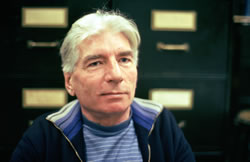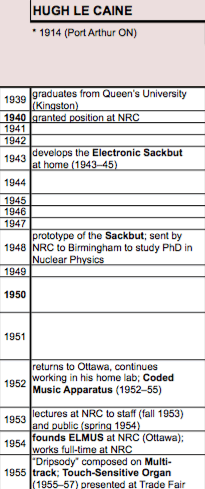An Artistic Genealogy of Hugh Le Caine 1939–1989
One only has to look at the “family tree” of the first generations of electronic music in North America to understand the impact Hugh Le Caine had on the establishment and subsequent development of the electronic music milieu in Canada. Lines can be traced from Le Caine to a handful of people who worked, collaborated or consulted with him in the 1950s and early 1960s, and onwards to larger numbers of people, and electronic music studios (EMS) that are an outgrowth of that first generation’s activities, in Canada and abroad, through the 1970s (Table 1).

In 1965, after his involvement in the design of the EMS at Brandeis University 1[1. The studio was equipped in the early 1960s with a voltage-controlled amplifier by Le Caine that was a precursor to later developments found in UTEMS or in the McGill EMS.], Gustav Ciamaga (page 2 of the chart) became the Director of the University of Toronto Electronic Music Studio (UTEMS), founded six years earlier. The next year, Pauline Oliveros discovered Le Caine’s instruments while taking summer courses with Ciamaga and Le Caine at UTEMS to help herself prepare for her new role as director of the Mills College Tape Music Center. A few years later, David Jaeger and James Montgomery passed through the studios, and would later co-found the Canadian Electronic Ensemble. The CEE formed the Hugh Le Caine Project in 1978 with Gayle Young, who published the foremost reference on the scientist / instrument designer / composer, Hugh Le Caine, a decade later.
In the Montréal branch (page 3 of the chart), István Anhalt first met Le Caine in Ottawa in 1957 and, after stints at the National Research Council (NRC) composing works using Le Caine instruments, spent a few years planning and preparing the McGill Electronic Music Studio, which he officially founded in 1964 — with substantial donations of instruments from ELMUS, Le Caine’s Electronic Music lab at the NRC. Paul Pedersen and alcides lanza were the studio’s subsequent directors, and Kevin Austin had studied with all three of these composers before he went on to found the electroacoustic studio at Concordia University in 1971 and, in the 1980s, laid the groundwork for the foundation in 1986 of the Canadian Electroacoustic Community (CEC).

The chart is by no means exhaustive: many names have not been included that, while perhaps important to the history of electronic music in Canada, would have otherwise made it unwieldy. Over the course of a couple of decades, as one can imagine, a great number of other people passed through these studios, either for single courses (R. Murray Schafer was also in the 1966 class with Oliveros) or as students (Bruce Pennycook, later known for his work in interactive, digital systems). Those people who have been included maintained more obvious relations over a period of many years with the studios where Le Caine’s instruments were found, or are recognized for their contributions to the development of the electronic music scene around those studios. The exclusion of any person in this chart should by no means be understood as passing judgement on the importance of that person’s contributions to the larger field of electroacoustic and electronic music; it is intended to be succinct and concise rather than comprehensive.
Reading the Chart
To the right of the UTEMS, McGill and Jerusalem lines are several columns that provide a broader frame of references during this 50-year period: important developments in electronic instrument design, significant compositions or projects, and the founding of various studios around the world (page 4 of the chart). Here as well there are, quite necessarily, some important omissions, but the genealogy is meant to show where Le Caine “fits” into the broader (hi)story of electronic music. Finally, the acquisitions of specific Le Caine instruments are listed to the far right of the chart. The dates for some of the acquisitions have not all been verified — memories are sketchy on some of the details, but as more clarifications come in, the chart will be updated. 2[2. The author welcomes any clarifications or corrections.]
Abbreviations Used in the Genealogy
HLC — Hugh Le Caine.
CEC — Communauté électroacoustique canadienne / Canadian Electroacoustic Community, Canada’s national association for electroacoustic and related arts, founded in 1986.
CECG/GEC — Concordia Electroacoustic Composers’ Group / Group Électroacoustique de Concordia (1982–89), initiated a series of tape music concerts that ran in various forms for 27 years.
CEE — Canadian Electronic Ensemble, founded in Toronto by David Grimes, David Jaeger, Larry Lake and James Montgomery for the live performance of electronic music.
CLAEM — Centro Latinoamericano de Altos Estudios Musicales, founded by Alberto Ginastera in 1962 at the Instituto Di Tella in Buenos Aires.
CPEMC — Columbia-Princeton Electronic Music Center, founded in 1958 by professors Vladimir Ussachevsky and Otto Luening (Columbia), and Milton Babbitt and Roger Sessions (Princeton).
GRMC — Groupe de Recherche de Musique Concrète, founded in 1951 by Pierre Schaeffer (who left it in 1953) and Pierre Henry, later the GRM.
EMS — Electronic Music Studio.
NAC — National Arts Centre (Ottawa), where Le Caine worked and developed his instruments.
NRC — National Research Council (Ottawa), where Le Caine worked and developed his instruments.
SSSG — Serial Sound Structure Generator.
UTEMS — University of Toronto Electronic Music Studio.
Bibliography
Anhalt, István. Alternative Voices: Essays on Contemporary Vocal and Choral Composition. Toronto: University of Toronto Press, 1984.
Austin, Kevin. “Historical Notes [1964–1990]” of the McGill Electronic Music Studio. Revised in 2001 by alcides lanza. http://www.music.mcgill.ca/dcs/History.php
_____. “[Institutions] Concordia University (Montréal).” eContact! 11.2 — Figures canadiennes 2 + TES 2008 / Canadian Figures 2 + TES 2008 (July 2009). https://econtact.ca/11_2/concordia_austin.html
_____. Private email correspondence. January 2016.
Beecroft, Norma. “Electronic Music in Toronto and Canada in the Analogue Era.” eContact! 11.2 — Figures canadiennes 2 + TES 2008 / Canadian Figures 2 + TES 2008 (July 2009). https://econtact.ca/11_2/beecroft_electronicmusic.html
CEC. “[Activities in Canada] CECG/GEC and ÉuCuE.” eContact! 10.x — Projet d’archivage Concordia / The Concordia Archival Project (March 2009). https://econtact.ca/10_x/activities_eucue.html
Clarke, F.R.C. “David Keane.” The Canadian Encyclopedia. Historica Canada, 2011. http://www.thecanadianencyclopedia.ca/en/article/david-keane-emc
Elliott, Robin and Gordon Smith. István Anhalt: Pathways and Memory. Montréal: McGill-Queen’s University Press, 2001.
Gluck, Bob and Shlomo Dubnov. “From ‘Enfant Terrible’ to Elder Statesman: Conversation with Israeli composer Josef Tal.” eContact! 15.2 — TES 2012: 6th Toronto Electroacoustic Symposium / 6e Symposium électroacoustique de Toronto (May 2013). https://econtact.ca/15_2/gluck-dubnov_tal.html
Henninger, Richard. Private email correspondence. January 2016.
Jaeger, David. Private email correspondence. January 2016.
Jones, Pamela. alcides lanza: Portrait of a Composer. Montréal: McGill-Queen’s University Press, 2007.
Keane, David R. “Electroacoustic Music in Canada 1950–1984.” eContact! 3.4 — Histoires de l’électroacoustique / Histories of Electroacoustics (2000). https://econtact.ca/3_4/EaMusicCanada.htm
Keillor, Elaine, Paul Mcintyre and Barclay McMillan. “Arnold Walter.” The Canadian Encyclopedia. Historica Canada, 2008, rev. 2015 by Andrew McIntosh. http://www.thecanadianencyclopedia.com/en/article/arnold-walter
lanza, alcides. “Multicanal Hugh Le Caine (I de II).” YouTube video (8:07) posted by “colegiocompositores” on 8 November 2007. https://youtu.be/gYQEYW0szEw [Last accessed 25 January 2016]
McMillan, Barclay and Elaine Keillor. “István Anhalt.” The Canadian Encyclopedia. Historica Canada, 2012. http://www.thecanadianencyclopedia.ca/en/article/istvan-anhalt
Wikipedia contributors. “Gustav Ciamaga.” Wikipedia: The Free Encyclopedia. Wikimedia Foundation Inc. http://en.wikipedia.org/wiki/Gustav_Ciamaga
_____. “Hugh Le Caine.” Wikipedia. http://en.wikipedia.org/wiki/Hugh_Le_Caine
_____. “István Anhalt.” Wikipedia. http://en.wikipedia.org/wiki/István_Anhalt
_____. “Moog synthesizer.” Wikipedia. http://en.wikipedia.org/wiki/Moog_synthesizer
_____. “Robert Moog.” Wikipedia. http://en.wikipedia.org/wiki/Robert_Moog
Various authors. eContact! 17.2 — The Quiet Legacy of Hugh Le Caine, Canadian Pioneer in Electronic Music (January 2016). https://econtact.ca/17_2
Young, Gayle. “Hugh Le Caine: Pioneer of Electronic Music in Canada.” HSTC Bulletin: Journal of the History of Canadian Science, Technology and Medecine / HSTC Bulletin : Revue d’histoire des sciences, des techniques et de la médecine au Canada 8/1, (26) 1984, pp. 20–31. Available online at http://id.erudit.org/revue/hstc/1984/v8/n1/800181ar.pdf [Last accessed 13 January 2016]
_____. The Sackbut Blues: Hugh Le Caine, Pioneer in Electronic Music. Ottawa: National Museum of Science and Technology, 1989.
_____. “Biography.” Hugh Le Caine website. 1999. http://www.hughlecaine.com/en/biography.html
_____. “Instruments.” Hugh Le Caine website. 1999. http://www.hughlecaine.com/en/instruments.html
_____. “Hugh Le Caine: In Context, 2004.” eContact! 6.3 — Questions en électroacoustique / Issues in Electroacoustics (2003–04). https://econtact.ca/6_3/young_lecaine.html
_____. Private email correspondence. January 2016.
Social top